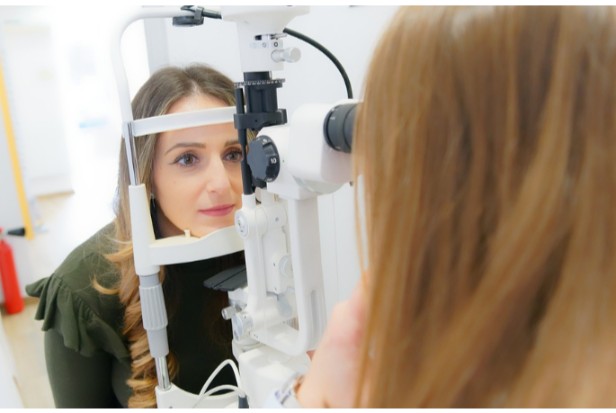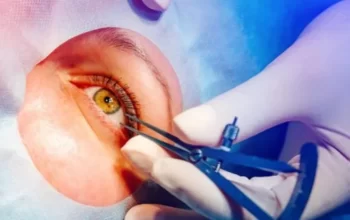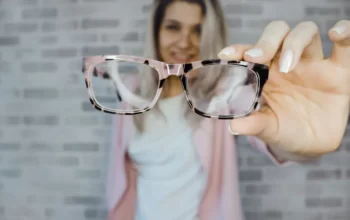
Learn useful advice and methods for applying glaucoma eye drops correctly in this guide. By easing eye pressure, latanoprost provides the much-needed relief. It’s a simple way to experience pain relief right away.
A medication called latanoprost, also referred to as prostaglandin analogs, can help lower intraocular pressure (IOP) and treat glaucoma both during the day and at night. When used the night before going to bed, it works best. Although it is secure to use in the morning, the effect is stronger at night. Check with your doctor to see if latanoprost is the right medication for you if you’re thinking about using it.
Glaucoma symptoms can be painful and challenging to manage. Along with other symptoms like seeing rings around lights or having blurry vision, you might also experience severe eye pain, nausea, and headaches.
When is the Best Time to Take Glaucoma Eye Drops?
A prospective study revealed that taking latanoprost (or any other glaucoma eye drop) before bedtime is the best time to do so. This is because using the medication at night will help keep the pressure in your eyes down throughout the day. Eye pressure is typically at its highest in the morning. For instance, it would be advised to apply a single dose twice daily, in the morning and evening, prior to brushing teeth.
When taking latanoprost or any other drug, it’s critical to adhere to your doctor’s recommendations. Additionally, you must follow the medication’s directions exactly and never miss a dose. Make sure to take the missed dose as soon as you remember if you miss one. It’s also important to remember that latanoprost is not a cure for glaucoma, but rather a way to manage the disease and
Make sure to take out any contact lenses before using eye drops to prevent any discomfort or harm to your eyes. Before putting your contact lenses back in after using it, wait at least 15 minutes.
Simply skip the missed dose and resume taking this eye drop according to your regular schedule if you forget to take a dose. For more information if you are unsure, speak to your doctor or pharmacist.
Why Should You Take Glaucoma Eye Drops at Night?
The pressure in your eyes is at its highest in the morning for a number of reasons, but the most significant one is that it is. Therefore, using glaucoma eye drops at night can help to maintain low pressure throughout the day.
Another justification is that latanoprost functions best at night. Although the medication can help with IOP reduction on the optic nerve both during the day and at night, it is most effective when taken just before bed.
It has been scientifically demonstrated that inconsistent use of drops is harmful and will raise or lower IOP. If you forget to take a dose, wait until you remember it later in the day to avoid harming your body with erratic doses.
Why is Travatan Z Taken at Night?
Another kind of glaucoma eye drop that lowers IOP is called Travatan Z. It works best when taken at night, just before bed, like latanoprost.
Travatan Z is usually taken at night for a few reasons. The use of the medication at night can help keep the pressure in your eyes down throughout the day because, among other things, it is highest in the morning when it is most intense.
Treatment for open-angle glaucoma or ocular hypertension with Travatan Z is efficient and well-tolerated. With only one drop in the evening, elevated eye pressure was significantly reduced without any side effects being yet reported.
Safe Ways to Apply Your Eye Drops
The best and safest way to apply eye drops are as follows:
- Wash your hands with soap and water.
- Verify that the eye drops are still in good condition by looking at the bottle’s expiration date.
- Without touching the dropper tip with anything, unscrew the bottle’s cap to reveal the contents.
- To make a tiny pocket, tilt your head back and pull down on your lower eyelid.
- Put one drop of medicine in the pocket by gently pressing.
- Apply gentle pressure for two to three minutes to the inside corner of your closed eye (near your nose). The medication won’t drain out because of this.
- If you are using eye drops in both eyes, repeat these procedures for the other eye.
- Wait at least five minutes before using the second eye drop if you are using more than one kind. This will stop the first eye drop from being washed out.
- The bottle should be kept in a cool, dry area or in your medication cooler after you have finished using the eye drops. Screw the cap back on.
After a year, half of the patients stop using the prescribed glaucoma eye drops, leaving them susceptible to vision loss. A once-daily routine before bed can help increase adherence and retention rates for this crucial medication.
Keep It Clean!
Before applying your eye drops, wash your hands. The dropper’s tip should not come in contact with your eye, eyelid, eyelashes, or fingers. Placing the bottle cap on a clean surface, such as a brand-new tissue, will help prevent contamination from another frequently disregarded source. Use a fresh tissue or an alcohol pad to clean the bottle tip if it becomes contaminated by accident. Also, keep in mind to close the bottle after every use because contaminated substances can more easily enter an open bottle. Avoid leaving your eye drop bottle in hot, direct sunlight, your car, or your pocket.
Find the “Pocket”
Tilt your head back when you’re standing or sitting, if you don’t have any neck issues. Another technique is to use a mirror in front of you as a guide. Although your head won’t be as tilted, some people find that using this technique helps them find the ideal spot to apply the drop. With the index finger of your non-dominant hand, gently pull down your lower eyelid to form a “pocket.” Squeeze one drop into the pocket in your lower lid with your dominant hand while taking a gentle look upward. Do not blink excessively (see the “Close and Press” tip below). For two minutes, keep your eye closed. Remove any extra eye drop by wiping it off with a fresh tissue. If your hands are shaky, brace the hand holding the bottle with your non-dominant hand while pulling your lower eyelid down. Following the above instructions without using a mirror will also work if you do have neck issues.

Close and Press
Patients frequently fret that they are not putting enough eye drops in their eyes because they feel some of the drops running down their faces. As discussed in the “Cold and Wet” tip below, a single drop is more than enough for the eye to handle. However, in order to help the eye drop penetrate your eye, the easiest thing to do is to keep your eyes closed for 2 minutes after instilling the drop because blinking activates the “pump” that drains your tears away from the eyeball. This is an excellent opportunity to unwind and give your body and mind a little rest.
Punctal Occlusion
A second way to ensure penetration of the eye drop into your eye is to perform “punctal occlusion.” This involves placing pressure for two minutes after applying the eye drop with a finger (your index finger is recommended). By squeezing it shut, you stop the medication from draining from your eyeball and into your nose. This area is where your eyeball’s drainage system for your tears is located. An added benefit of this technique is that it prevents the medication from entering the nose, throat, and the rest of the body, minimizing any potential negative effects that the eye drops may have on your body as a whole. As a result, it is best to combine the two techniques when applying eye drops: close your eyes and press firmly on the inside corners for two minutes after applying a drop.
Timing is (sort Of) Everything
Patients frequently ask about the best times to administer various eye drops as well as how long they should wait between doses. It is advised to wait five minutes (or at least three minutes if you’re pressed for time) between using different eye drops because the first eye drop can wash out the second if it is injected into the eye too quickly. Unless you are using an ointment, it is irrelevant which eye drops you apply first when applying two or more different kinds at once. Once you’ve injected all of your eye drops, you should finish by applying an ointment.
There are some medications that, in terms of timing, are better taken in the morning and others that are better taken in the evening for a drop that is taken once daily. For instance, one class of medications, the prostaglandin analogues (which include latanoprost, bimatoprost, and travoprost), should be administered once daily at bedtime. The ideal dosing schedule for drops that must be administered twice daily is every 12 hours, and the ideal schedule for drops that must be administered three times daily is every 8 hours. However, there are times when that is not practical, so having an hour or two of leeway (early or late) should be acceptable. Making sure you administer the drops the appropriate number of times each day is the most crucial step.
“Cue” Yourself
Many patients struggle to remember to take their eye drops because they either forget, the day just gets away from them, or they are already taking so many other medications that they end up forgetting to take their glaucoma drops. Utilizing your eye drops while performing another daily task is an efficient way to make sure you remember to take them. For instance, if you have a drop that needs to be applied twice daily, you could do so before or after brushing your teeth, or before eating breakfast and dinner. You could also keep the eye drops next to your toothbrush if you were using teeth brushing as your “cue.” Multiple alarms can be set, for example, on your phone, as an alternative strategy. A third strategy is to keep a chart and mark each time you use an eye drop with a checkmark.
Cold and Wet
Because they feel the eye drop mostly on their cheeks, patients frequently report that they are unsure if enough of it entered their eyes. Although the exact size of each eye drop varies, all bottles are made so that each eye drop contains much more medication than your eyeball can even handle. This means that you can be sure that enough medication has reached your eye and that you do not need to worry if too much drips down your cheek. This also means that you shouldn’t intentionally use two or more drops to try to get more medication into your eye because you will waste the medicine. The refrigerator is another tip for keeping eye drops. When you feel a cold sensation in your eye, you will know that the eye drop has reached your eye.
Talk to Your Pharmacist
Some eye drops are available in bottles of all different sizes and shapes now that many glaucoma medications have become generic. Speak with your pharmacist if you find it difficult to squeeze the bottle or if you notice that, despite only using one drop at a time, you are using drops too quickly. He or she might be able to advise you to use the bottle properly or suggest a different generic formulation that would be better suited to your needs.
Get An Audience
Showing your ophthalmologist how to administer eye drops is always a good idea. He or she can give you advice on how to administer the medication and make sure you are doing it correctly. When you are first learning, you can also request that a family member or friend watch you apply your eye drops. Don’t be afraid to ask for assistance either. Ask family and friends for assistance administering the eye drops while following the above instructions if you are having trouble because of medical conditions that even practice cannot cure, such as severe arthritis.
Soothe Your Eyes
Many of the glaucoma eye drops used for treatment irritate the eye, and some eye drops also burn when administered. Use artificial tears (preferably preservative-free if you have sensitive eyes or are using a variety of glaucoma eye drops) BEFORE applying your glaucoma eye drops as one way to help with this. Prior to starting your glaucoma eye drops, you should wait five minutes after applying the artificial tears. There are also over the counter gels or ointments used at nighttime (often they are labeled “PM”) that are thicker and can help soothe your eyes overnight. If you do decide to use these formulations, be sure to use the gel or ointment last and wait five minutes after applying your final glaucoma drop. Tell your ophthalmologist about all of your eye drops, including over-the-counter items like artificial tears, as you should do every time.
Bonus Tips
Every time you have an appointment, bring eye drops with you. In this manner, any ambiguity regarding your eye drop regimen and schedules can be easily resolved, and your eye doctor will be able to record precisely what drops you are using, including which formulation.
It takes time and practice to become proficient at applying eye drops. To practice without wasting your glaucoma medications, use a bottle of artificial tears.
Frequently Asked Questions
Can You Take Latanoprost in the Morning?
You certainly can, but it works best when done at night before bed. This is due to the fact that your eyes’ pressure is highest in the morning, and taking the medication at night can help keep it low throughout the day. Although taking a dose in the morning won’t hurt, it’s preferable to take a dose in the evening in the affected eye to help lower IOP.
How Long Do You Keep Your Eyes Shut After Using Glaucoma Drops?
Eye drops are typically absorbed within a minute or two, but it’s crucial to keep your eyes closed for at least two minutes after applying them. By doing this, the medication won’t drain out.
Does Latanoprost Need to Be Refrigerated?
Yes, latanoprost needs to be kept cold. There’s no need to freeze it.
In order to prevent Latanoprost from working as effectively as possible, keep them away from heat and direct sunlight.
Which Eye Drops for Glaucoma Have the Least Side Effects?
Prostaglandin eye drops are considered the most effective class of medication for glaucoma. Additionally, they typically don’t have many side effects and only require one daily use. Beta blockers: These reduce the amount of fluid produced in the eyes. These are other classes of glaucoma eye drops available by prescription.
What Are Common Side Effects of Latanoprost
Latanoprost is a good option to take into consideration if you’re looking for a medication to help lower your IOP. It is risk-free, efficient, and both a treatment and preventative measure. To determine if it is appropriate for you, be sure to consult your doctor first.
Latanoprost generally has few side effects and is well tolerated. The most frequent adverse reaction is an initial stinging or burning of the eyes after using the drops. Most of the time, this disappears quickly. Other possible side effects include transient changes in eye color, darkening of the eyelids, inflammation, and itchy eyes. Others may experience redness, itchiness, or pain near their eyes for a variety of reasons, including blepharitis.
How Long Do Eye Drops Take to Work on Conjunctivitis
If you have bacterial conjunctivitis, it should improve within a week. Even if your symptoms go away, always follow your doctor’s instructions when taking any medication. Four to seven days is the typical duration of viral conjunctivitis. The full resolution can take up to 14 days.



